The 1930s marked a golden era in men’s grooming, where sophistication met practicality in the most elegant ways imaginable.
When you explore 33 Stylish 1930s Hairstyles for Men That Define Retro Charm, you’re stepping into a world where every gentleman understood the power of a well-groomed appearance.
This decade brought us iconic looks that have transcended time, from the sleek pompadour to the distinguished side part, each style telling a story of refinement and masculine elegance.
These hairstyles weren’t just about fashion; they represented a lifestyle of attention to detail, class, and timeless appeal that modern men continue to embrace and reinterpret.
Whether you’re seeking inspiration for a vintage-themed event, looking to add classic elements to your personal style, or simply fascinated by the evolution of men’s grooming, this comprehensive guide will walk you through the most defining hairstyles of the 1930s.
You’ll discover the techniques, products, and cultural significance behind each look, understanding why these styles remain relevant nearly a century later and how you can adapt them to contemporary life.
Contents
- 1 1. The Classic Slicked-Back Pompadour
- 2 2. The Distinguished Side Part
- 3 3. The Short Back and Sides
- 4 4. The Finger Wave Style
- 5 5. The Tapered Nape Cut
- 6 6. The Brushed-Up Quiff
- 7 7. The Military Regulation Cut
- 8 8. The Vintage Ivy League
- 9 9. The Contoured Pompadour
- 10 10. The Textured Crop
- 11 11. The Rounded Pompadour
- 12 12. The Razor-Sharp Fade
- 13 13. The Executive Side Sweep
- 14 14. The Natural Wave Enhancement
- 15 15. The Prohibition-Era Slick
- 16 16. The Graduated Temple Fade
- 17 17. The Crown Volume Style
- 18 18. The Businessman’s Brush-Back
- 19 19. The Distinguished Gray Temples
- 20 20. The Vintage Crew Cut
- 21 21. The Sculpted Part Line
- 22 22. The Swept Forward Fringe
- 23 23. The Vintage Ducktail
- 24 24. The Professional Flat Top
- 25 25. The Vintage Pompadour with Shine
- 26 26. The Conservative Temple Trim
- 27 27. The Layered Crown Cut
- 28 28. The Urban Slick Back
- 29 29. The Vintage Side Sweep with Volume
- 30 30. The Working Man’s Practical Cut
- 31 31. The Sophisticated Temple Fade
- 32 32. The Classic Gentleman’s Wave
- 33 33. The Art Deco Architectural Style
- 34 Key Styling Techniques from the 1930s
- 35 Cultural Significance of 1930s Men’s Hairstyles
- 36 How to Achieve Authentic 1930s Styling Today
- 37 Common Mistakes to Avoid
- 38 Modern Adaptations and Contemporary Relevance
- 39 Conclusion
1. The Classic Slicked-Back Pompadour

The slicked-back pompadour dominated the 1930s as the ultimate symbol of masculine sophistication and social status.
This hairstyle featured hair swept dramatically upward and backward from the forehead, creating volume and height that commanded attention in any room.
- The pompadour required considerable length on top, typically 3 to 5 inches, while the sides were kept shorter for contrast and manageability.
- Gentlemen achieved this look using heavy pomades and hair oils, applying generous amounts to damp hair before combing everything back with precision.
- The style worked best with naturally thick or wavy hair, though men with finer textures used various techniques and products to create the illusion of volume.
- Morning grooming routines centered around this hairstyle, with men often spending 15 to 20 minutes perfecting the shape and ensuring it would last throughout the day.
- The pompadour complemented the formal attire of the era, including three-piece suits and fedoras, creating a cohesive look of refinement.
2. The Distinguished Side Part
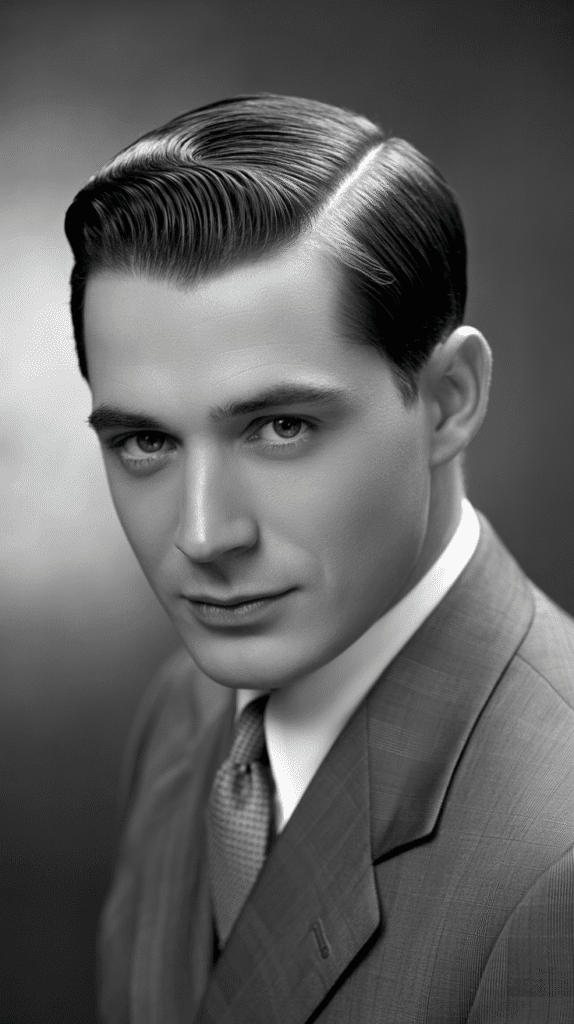
The side part emerged as the most versatile and widely adopted hairstyle of the 1930s, suitable for both professional and casual settings.
This timeless look involved creating a clean, sharp parting on one side of the head, typically positioned about an inch from the center.
- Barbers used straight razors or fine-toothed combs to create razor-sharp parts that became a signature element of the style.
- The hair on the heavier side was combed smoothly across and slightly back, while the opposite side lay flat against the head.
- This hairstyle required regular maintenance, with most men visiting their barbers weekly to maintain the precision of the part and the overall shape.
- Different part positions conveyed subtle messages about personality, with left parts being most common and center parts suggesting a more artistic or unconventional character.
- The side part transitioned seamlessly from office environments to evening social events, making it the practical choice for working professionals.
3. The Short Back and Sides
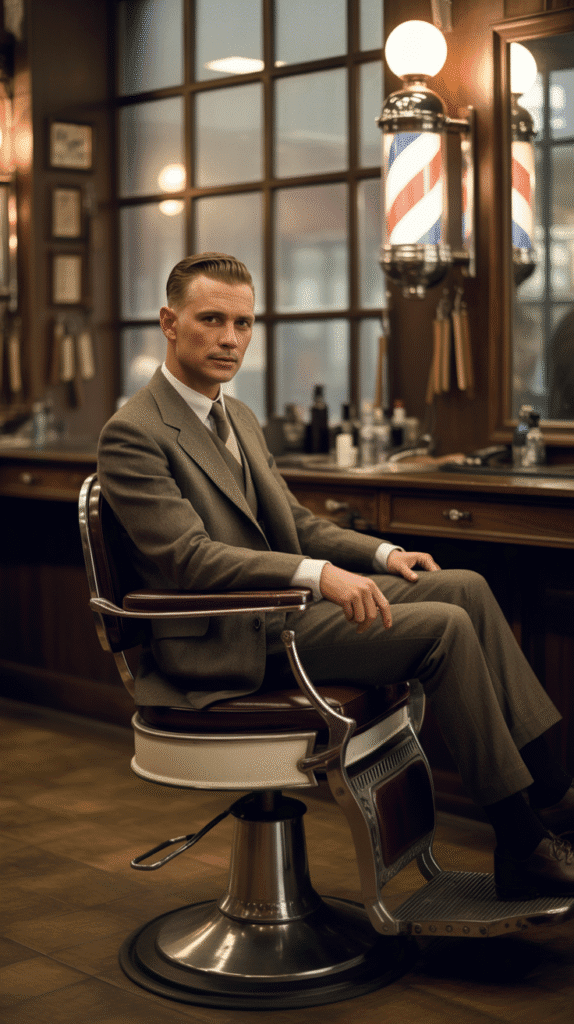
The short back and sides represented a more practical approach to 1930s grooming, favored by working-class men and military personnel.
This cut featured closely cropped hair on the sides and back while maintaining moderate length on top for styling flexibility.
- Barbers used manual clippers to achieve the graduated fade from the shorter sides to the longer top section.
- The top portion typically measured 2 to 3 inches, providing enough length for a modest side part or slight pompadour effect.
- This style required less daily maintenance than more elaborate looks, making it ideal for men with active lifestyles or physically demanding jobs.
- Military influence heavily shaped this haircut’s popularity, as armed forces regulations necessitated neat, practical grooming standards.
- The short back and sides provided a foundation that could be adapted to various styling preferences, from slicked back to textured and natural.
4. The Finger Wave Style
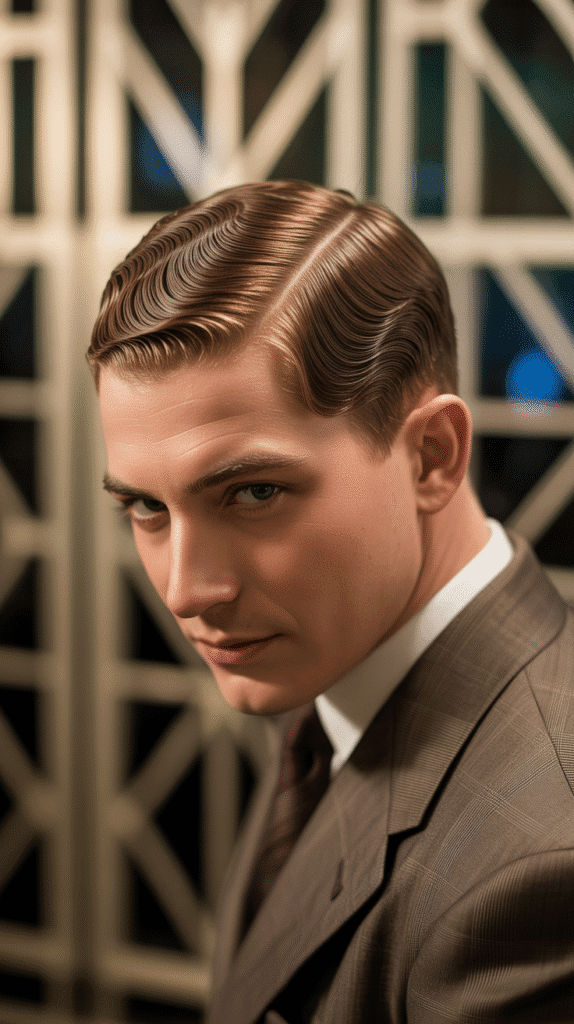
Finger waves brought an artistic, sculptural quality to men’s hairstyles in the 1930s, creating S-shaped patterns that showcased grooming expertise.
This technique involved molding damp hair into waves using fingers, combs, and setting lotions, resulting in a polished, textured appearance.
- The creation process required significant skill, with experienced barbers or the men themselves using their fingers to shape each wave while applying pressure.
- Setting lotions or thick pomades were essential for holding the waves in place as they dried, creating a firm yet natural-looking finish.
- Finger waves worked particularly well with shorter to medium-length hair, typically between 2 to 4 inches on top.
- This style appealed to fashion-forward gentlemen who appreciated the artistic element and were willing to invest time in their grooming routine.
- The waves caught and reflected light beautifully, adding dimension and visual interest that photographs and film captured dramatically.
5. The Tapered Nape Cut
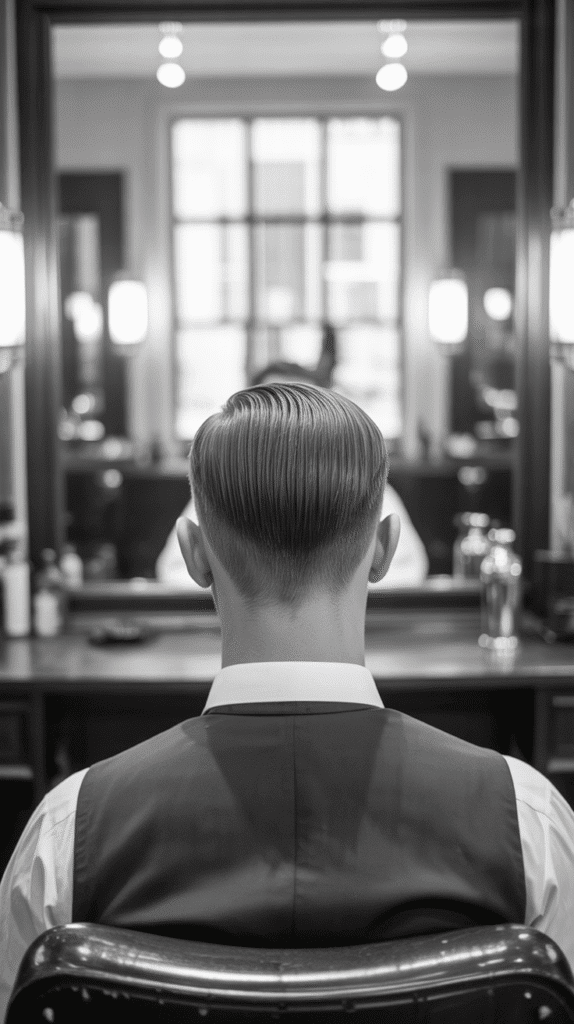
The tapered nape cut emphasized clean lines at the back of the head, creating a gradual transition from longer hair on top to skin at the neckline.
This detail-oriented style showcased the precision barbering skills that defined 1930s grooming standards.
- Barbers achieved the taper using various clipper guards and blending techniques, creating a smooth gradient without harsh lines.
- The neckline received special attention, with many men preferring either a rounded or squared-off shape depending on personal preference and head structure.
- Regular maintenance every 10 to 14 days was necessary to keep the taper looking sharp and professional.
- This cut paired well with virtually any top styling, from pompadours to side parts, serving as a universally flattering foundation.
- The tapered nape reflected the era’s appreciation for craftsmanship and attention to detail in all aspects of personal presentation.
6. The Brushed-Up Quiff
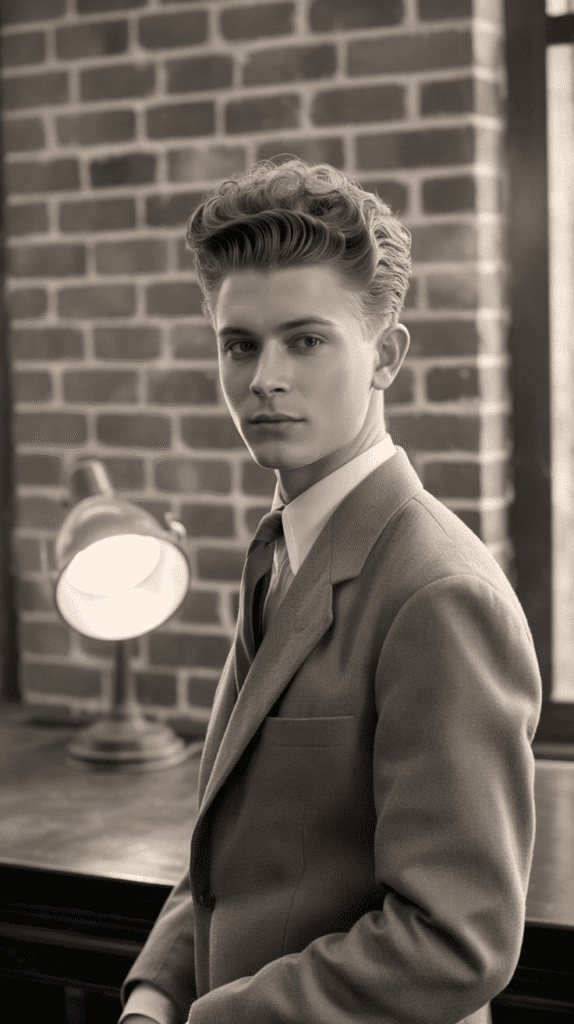
The brushed-up quiff offered a slightly more casual yet still refined alternative to the formal pompadour, featuring hair swept upward and forward from the hairline.
This style struck a balance between volume and practicality, appealing to younger men and those in creative professions.
- The quiff required 3 to 4 inches of length at the front, with hair gradually decreasing in length toward the crown.
- Styling involved using a round brush or fingers to lift and direct hair upward and slightly back, creating natural-looking height.
- Medium-hold pomades or brilliantines provided enough structure to maintain the shape while allowing some movement and natural texture.
- This style worked exceptionally well with naturally wavy or curly hair, which provided built-in volume and character.
- The quiff projected youthful confidence and approachability while maintaining the polished standards of 1930s grooming.
7. The Military Regulation Cut
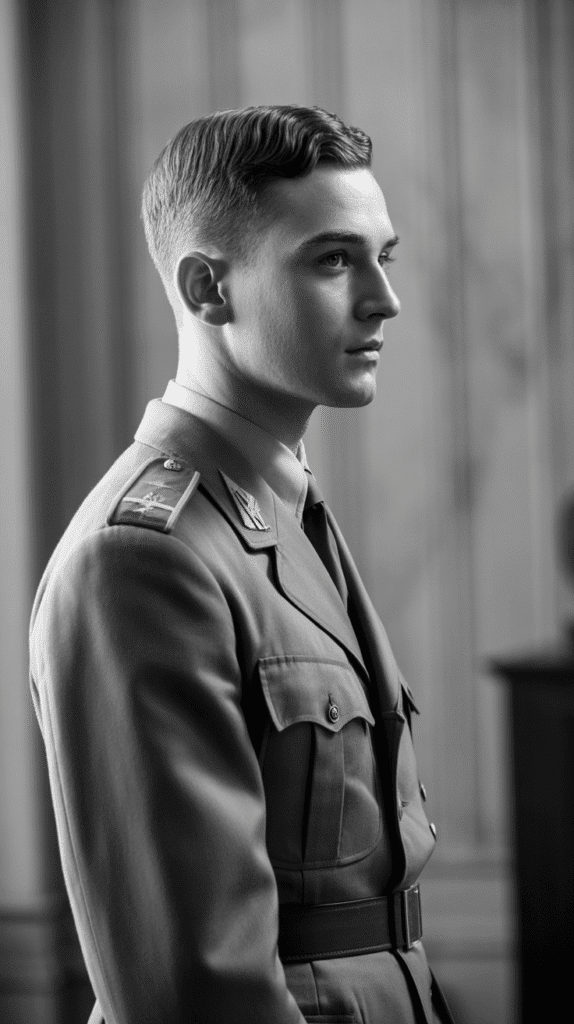
The military regulation cut embodied functionality and discipline, setting standards that influenced civilian grooming throughout the 1930s.
This no-nonsense style featured uniform short length all over, typically no longer than one inch, with an emphasis on neatness and ease of maintenance.
- Military barbers could execute this cut quickly and efficiently, often completing it in under 10 minutes using manual clippers.
- The style eliminated the need for styling products or elaborate morning routines, making it ideal for military life and physically active civilians.
- Despite its simplicity, the regulation cut maintained a clean, respectable appearance that aligned with societal expectations for men’s grooming.
- Veterans returning to civilian life often maintained this style, appreciating its practicality and the reduced time investment required.
- The cut’s influence extended beyond military contexts, affecting workplace grooming standards and social perceptions of professionalism.
8. The Vintage Ivy League
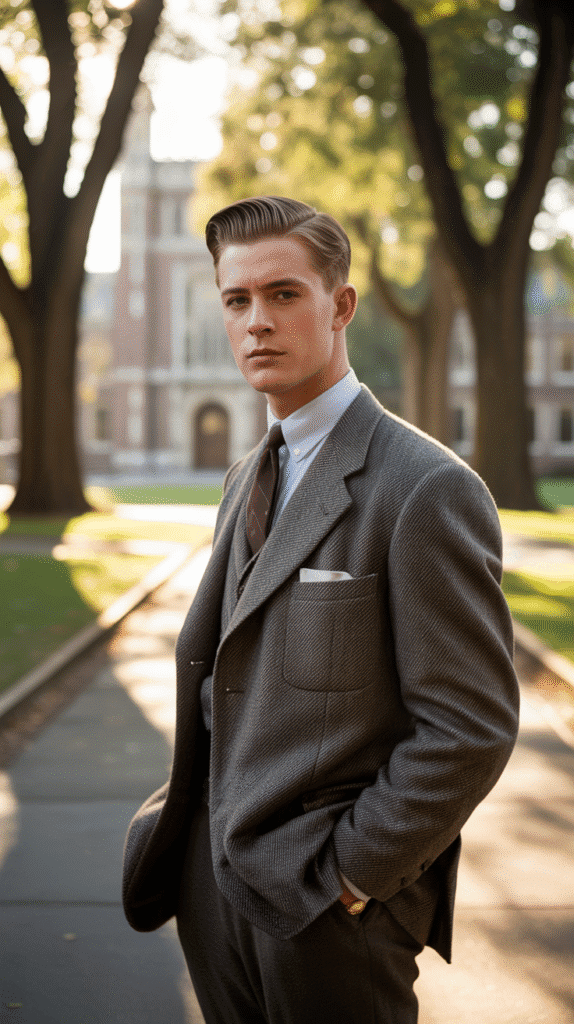
The Ivy League cut represented the preppy aesthetic of elite American universities, combining conservative length with refined styling options.
This versatile cut featured slightly longer hair on top than the crew cut, typically 1.5 to 2.5 inches, allowing for a subtle side part or forward styling.
- The name originated from the prestigious Ivy League universities where this style became synonymous with academic achievement and social status.
- Barbers created a gradual taper on the sides and back, maintaining enough length to avoid severe contrast with the top section.
- The style could be worn combed forward for a more casual look or swept to the side with a part for formal occasions.
- Light to medium-weight pomades provided hold without the heavy, wet appearance of more formal 1930s styles.
- This cut appealed to educated, upwardly mobile young men who wanted to project intelligence and sophistication without appearing overly formal.
9. The Contoured Pompadour
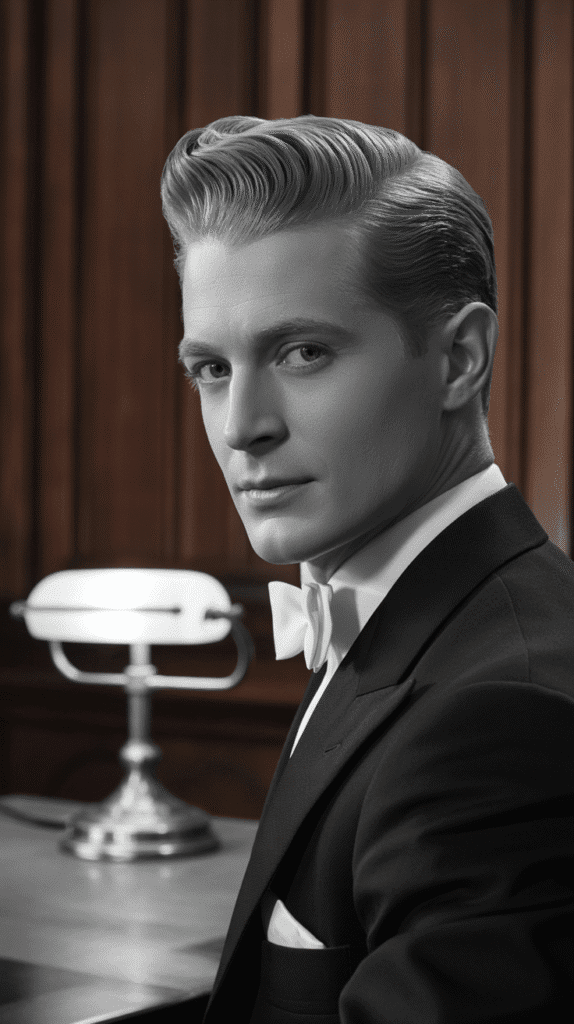
The contoured pompadour advanced the basic pompadour by adding shaped elements and deliberate curves that enhanced facial features.
This sophisticated variation required expert barbering skills and precise styling to achieve the sculptural quality that defined it.
- Barbers cut the hair with specific angles and lengths to naturally fall into the desired contoured shape when styled.
- The sides were often cut shorter with a subtle fade, drawing attention to the carefully shaped volume on top.
- Styling involved applying pomade to damp hair, then using a combination of combing and hand-shaping to create smooth curves and defined edges.
- The contour followed the natural shape of the head while adding deliberate architectural elements that elevated the look beyond basic slicked-back styles.
- This advanced technique showcased both the barber’s artistry and the wearer’s commitment to personal grooming excellence.
10. The Textured Crop
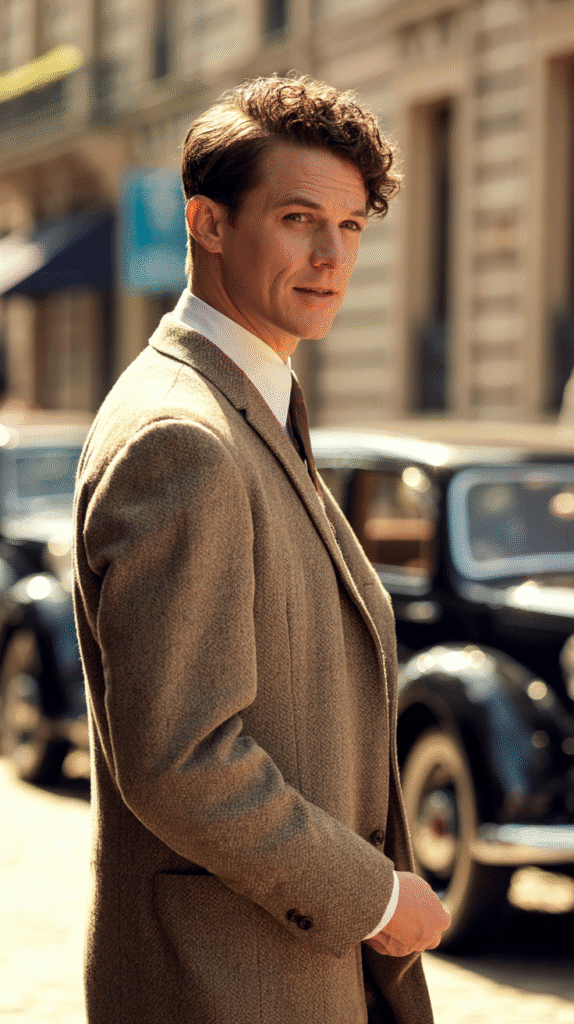
The textured crop offered a more natural, lived-in alternative to heavily pomaded styles, allowing the hair’s natural texture to remain visible.
This approach represented a subtle rebellion against overly groomed appearances while still maintaining respectability.
- Hair was cut to 2 to 3 inches on top with textured layers that created movement and dimension rather than smooth uniformity.
- Minimal product usage allowed natural texture to show through, with just enough pomade or light oil to add shine and slight control.
- This style worked particularly well for men with naturally wavy or curly hair who wanted to embrace their texture rather than fight against it.
- The textured crop projected a more relaxed, artistic sensibility while remaining appropriate for most social and professional settings.
- Styling involved towel-drying hair and using fingers to direct it into place rather than precise combing, creating an effortlessly handsome appearance.
11. The Rounded Pompadour
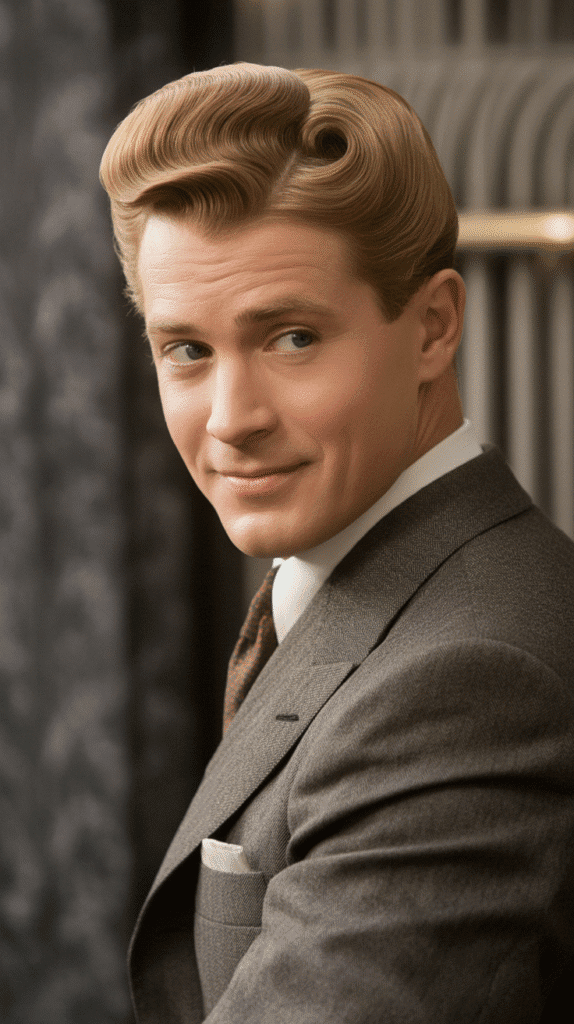
The rounded pompadour softened the angular severity of classic pompadours by creating curved, dome-like volume that appeared more approachable.
This variation maintained the sophistication of traditional pompadours while introducing organic, flowing lines.
- The shaping technique emphasized smooth, continuous curves from the hairline back to the crown, avoiding harsh angles or breaks.
- Barbers cut the hair slightly shorter at the front and gradually longer toward the crown to facilitate the rounded shape.
- Styling required working pomade through damp hair, then using a round brush or curved comb to shape the hair into the desired arc.
- The rounded silhouette complemented round or square face shapes particularly well, adding vertical dimension while maintaining softness.
- This style projected warmth and accessibility while preserving the elegance associated with pompadour-style haircuts.
12. The Razor-Sharp Fade
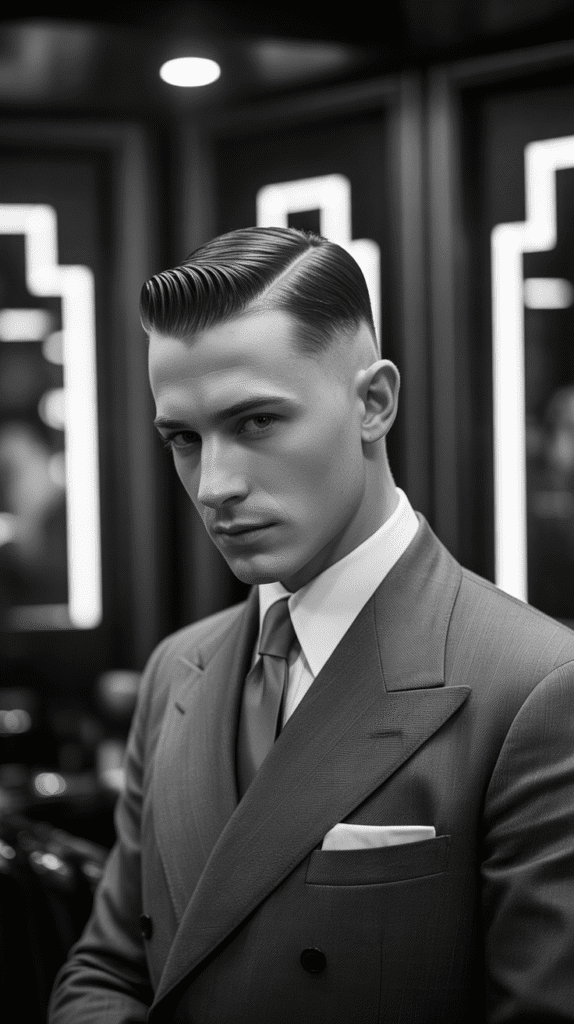
The razor-sharp fade demonstrated precision barbering at its finest, featuring a graduated transition from longer hair on top to closely shaved sides.
This technique required exceptional skill and attention to detail, marking the barber’s craftsmanship.
- Barbers used straight razors and multiple clipper guards to create seamless transitions between different hair lengths.
- The fade typically began at the temple area and extended down to the natural hairline, creating a clean, dramatic contrast.
- Regular maintenance every 7 to 10 days was essential to preserve the fade’s sharpness and prevent the lines from growing out unevenly.
- This style particularly appealed to fashion-conscious men who appreciated bold, statement-making grooming choices.
- The razor-sharp fade influenced future decades of barbering, establishing techniques that barbers still use and refine today.
13. The Executive Side Sweep
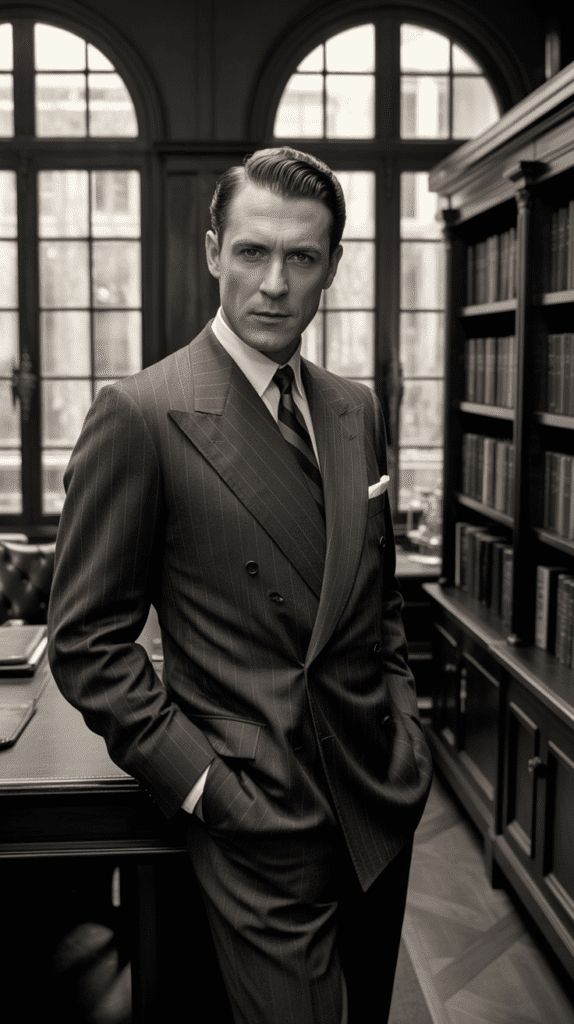
The executive side sweep exuded authority and professional polish, featuring hair combed from a deep side part across the head in smooth, unbroken lines.
This style became synonymous with business leadership and financial success during the 1930s.
- The part was positioned quite far to one side, often just above the temple, creating dramatic asymmetry.
- Hair on the fuller side was combed straight across toward the opposite side, sometimes covering a portion of the forehead.
- Heavy pomades ensured the hair remained in place throughout long business days and important meetings.
- The style worked best with straight or slightly wavy hair that could be trained to lie flat without resistance.
- This look paired perfectly with the power dressing of the era, including pinstripe suits, silk ties, and gold accessories.
14. The Natural Wave Enhancement
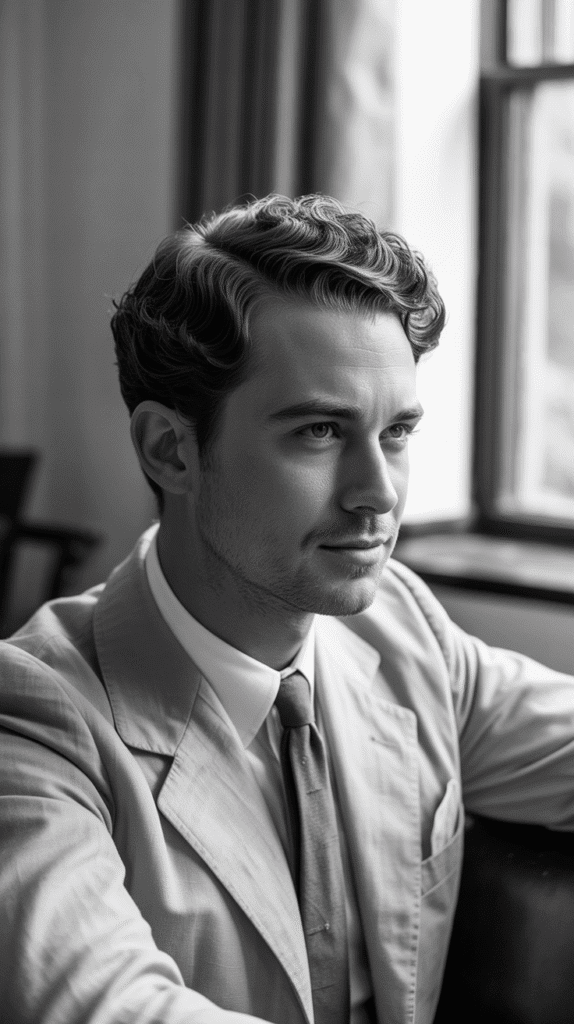
The natural wave enhancement celebrated rather than suppressed the hair’s inherent texture, using products and techniques to define and polish natural waves.
This approach acknowledged that not all men could or wanted to achieve perfectly smooth styles.
- Light pomades or hair tonics enhanced waves without flattening them, adding shine and definition while maintaining natural movement.
- Barbers cut the hair to work with natural growth patterns, creating shapes that complemented rather than fought against the hair’s tendencies.
- The styling process involved applying product to damp hair and using fingers or a wide-toothed comb to encourage waves into attractive patterns.
- This style appealed to men who valued authenticity and comfort over rigidly structured grooming routines.
- Natural wave enhancement required less daily maintenance than heavily styled alternatives while still appearing polished and intentional.
15. The Prohibition-Era Slick
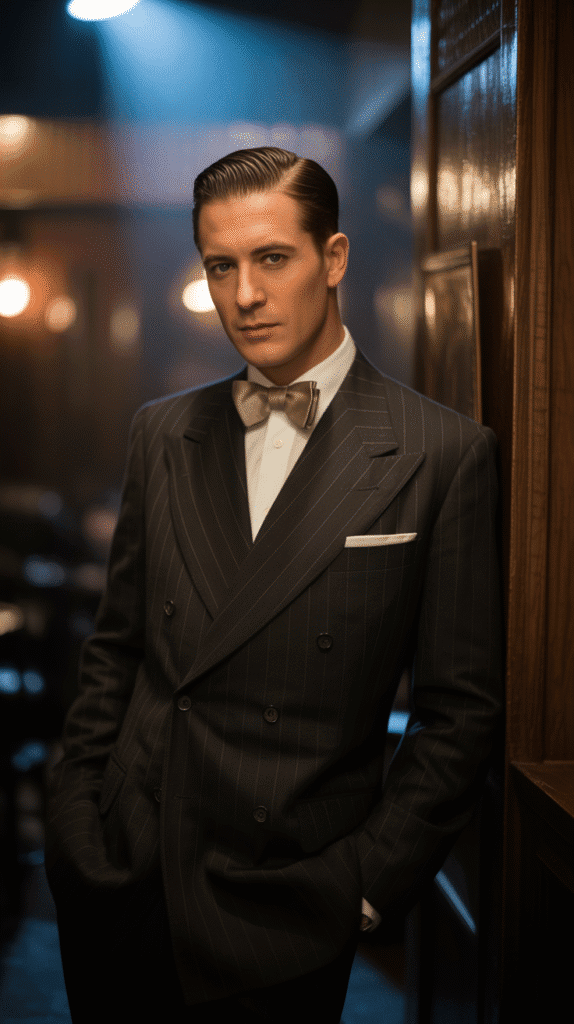
The Prohibition-Era slick became associated with the speakeasy culture and jazz age sophistication, featuring ultra-smooth, wet-looking hair combed straight back.
This bold style made a statement about the wearer’s confidence and social awareness.
- Generous amounts of heavy pomade created the characteristic high-shine, wet appearance that defined this look.
- Hair was combed straight back from the forehead without parting, creating uninterrupted lines from front to back.
- The style worked with various hair lengths, though 3 to 4 inches on top provided the best results for creating smooth, controlled styling.
- This look particularly thrived in urban environments and nightlife settings, where its dramatic appearance commanded attention.
- The Prohibition-Era slick represented a rejection of conservative Victorian grooming standards in favor of modern, daring self-expression.
16. The Graduated Temple Fade
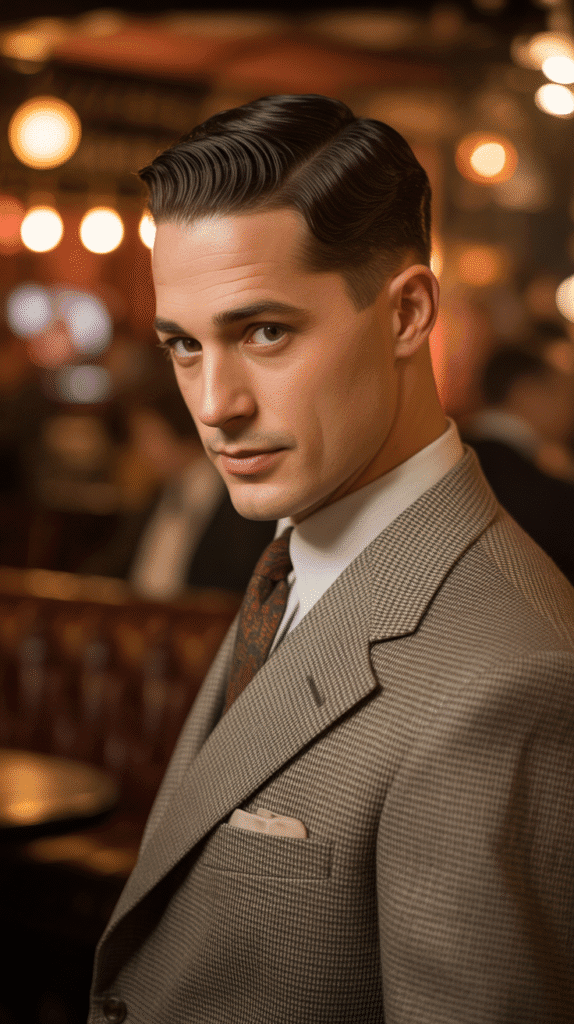
The graduated temple fade focused attention on the areas around the temples, creating precise transitions that framed the face effectively.
This technique added modern sophistication to traditional 1930s cuts while maintaining period-appropriate styling.
- Barbers worked carefully around the temple area, creating fades that could be subtle and conservative or bold and dramatic depending on preference.
- The fade enhanced facial structure by drawing the eye to strong jawlines and cheekbones while keeping attention on the face.
- This detail work required 20 to 30 minutes of careful barbering to execute properly, reflecting the era’s commitment to quality grooming.
- The graduated temple fade complemented both slicked-back styles and textured looks, serving as a versatile foundational element.
- Regular touch-ups every 10 to 14 days maintained the fade’s definition and prevented it from growing out unevenly.
17. The Crown Volume Style
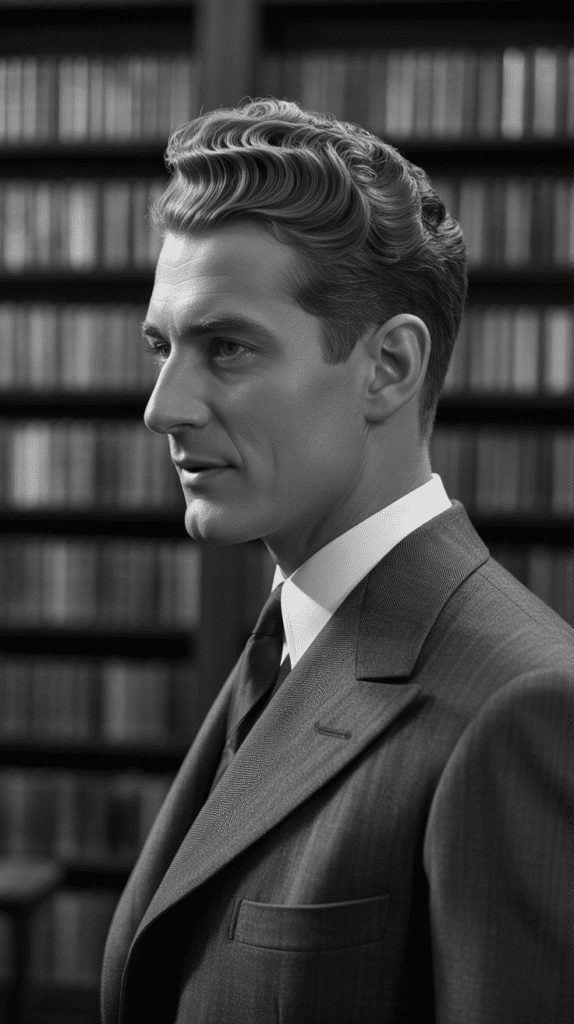
The crown volume style concentrated height and fullness at the crown of the head, creating vertical dimension that elongated the face and projected confidence.
This technique involved strategic cutting and styling to achieve impressive height without appearing artificial.
- Barbers cut the crown area slightly longer than surrounding sections, providing a foundation for building volume through styling.
- Blow-drying techniques, though less common in the 1930s, were sometimes used in upscale salons to create lift before setting with pomade.
- The hair was combed upward and back from the crown, with the sides kept smooth to emphasize the vertical height.
- This style particularly benefited men with round or wide faces, as the added height created a more balanced overall appearance.
- Crown volume required strong-hold pomades and sometimes hairpins or clips during the setting process to maintain the dramatic lift.
18. The Businessman’s Brush-Back
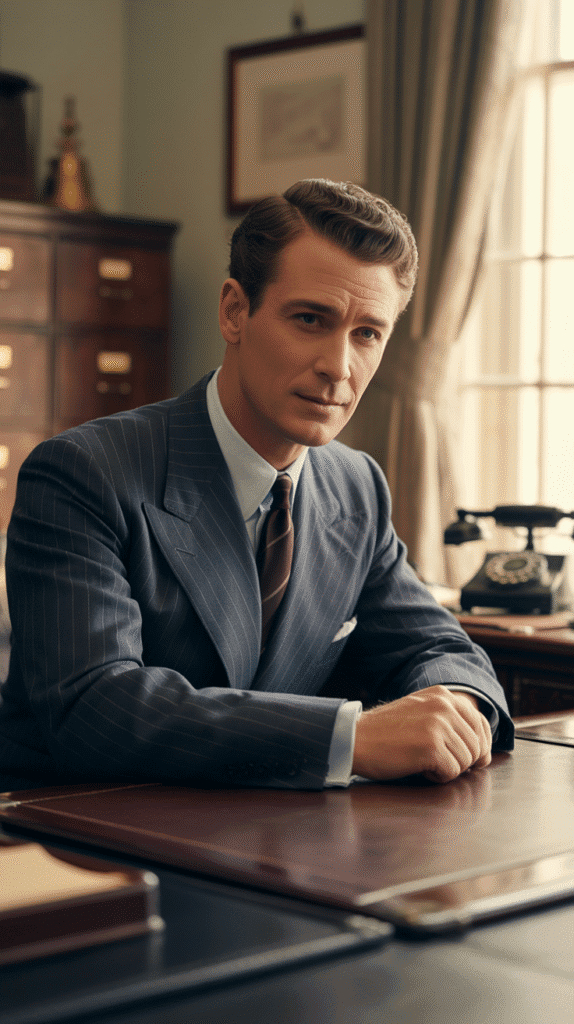
The businessman’s brush-back represented practical elegance for professional men who needed to look polished without excessive styling time.
This efficient style featured hair brushed straight back from the forehead with subtle volume and natural texture.
- The styling process took only 5 to 10 minutes, making it ideal for busy professionals with morning time constraints.
- Medium-hold pomades provided structure without the stiffness or shine of heavier products, creating a more contemporary business appearance.
- Hair length typically ranged from 2 to 3.5 inches on top, enough for noticeable style but manageable for daily maintenance.
- The brush-back worked well under hats, which businessmen frequently wore, as it maintained its shape when the hat was removed.
- This style conveyed competence and reliability, important qualities for men building careers during economically challenging times.
19. The Distinguished Gray Temples
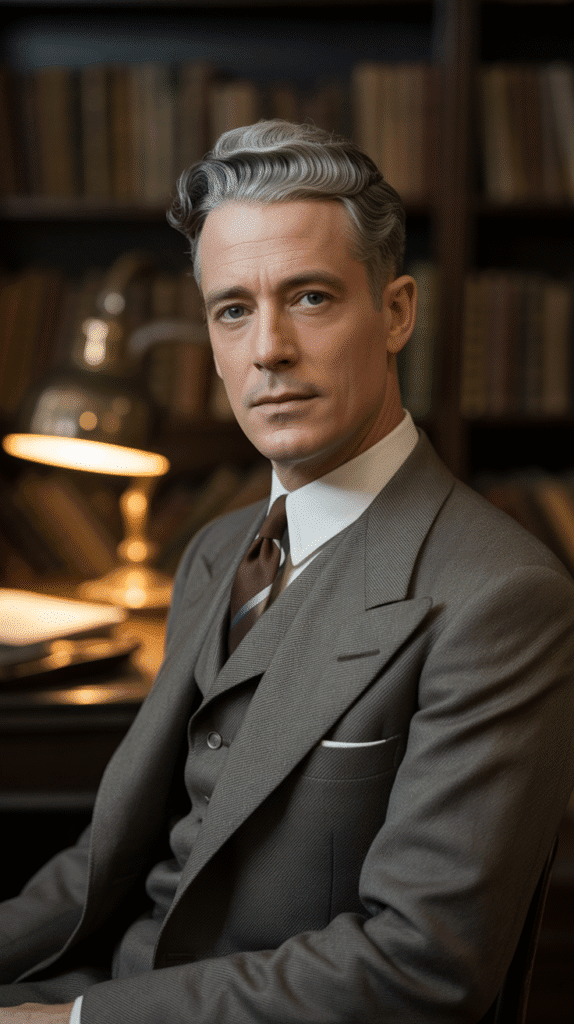
The distinguished gray temples style celebrated rather than concealed graying hair, incorporating silver strands into sophisticated styling that enhanced mature masculine appeal.
This approach reflected changing attitudes toward aging and experience during the later 1930s.
- Barbers cut and styled gray hair with the same care as darker shades, using techniques that showcased the natural color variation.
- The contrast between darker crown hair and gray temples created visual interest and dimension that enhanced the overall style.
- Light pomades were preferred for gray hair, as they provided hold without yellowing or dulling the silver tones.
- This style worked particularly well with side parts, as the parting naturally divided the darker and lighter sections.
- Distinguished gray temples projected wisdom, experience, and confidence, qualities increasingly valued as the decade progressed.
20. The Vintage Crew Cut
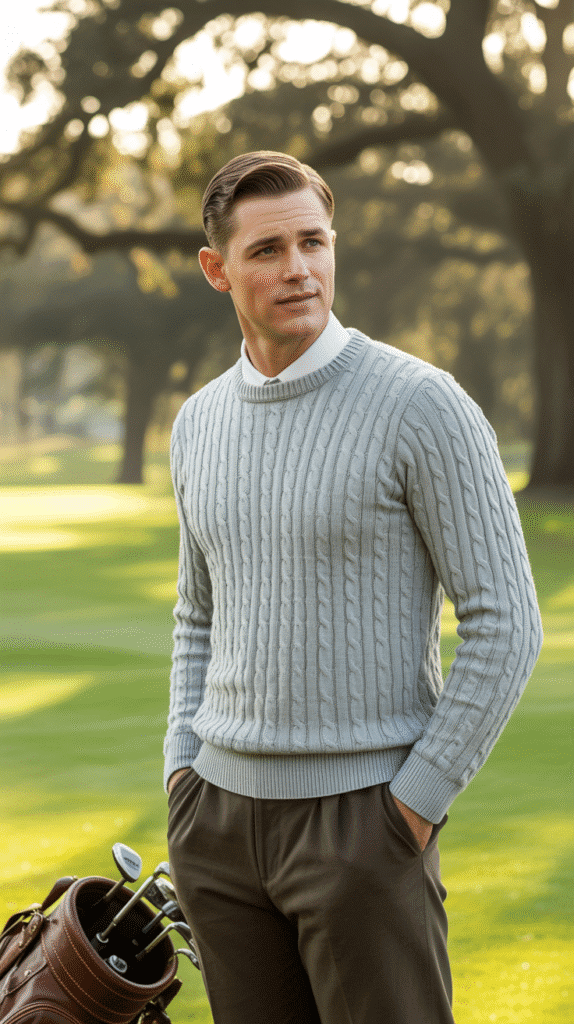
The vintage crew cut offered maximum practicality while maintaining respectability, featuring uniform short length across the top with slightly shorter sides and back.
This athletic, no-fuss style appealed to active men and those who prioritized function over elaborate grooming.
- Hair on top measured approximately 1 inch in length, just enough to provide slight texture and direction without requiring extensive styling.
- The front was often left slightly longer than the crown, creating a subtle forward slope that added dimension to the simple cut.
- Minimal product application was necessary, typically just a small amount of light pomade or hair tonic for shine and control.
- This style dried quickly after washing and maintained its shape throughout the day without requiring adjustments or touch-ups.
- The crew cut’s military associations gave it connotations of discipline, patriotism, and physical fitness that appealed across social classes.
21. The Sculpted Part Line
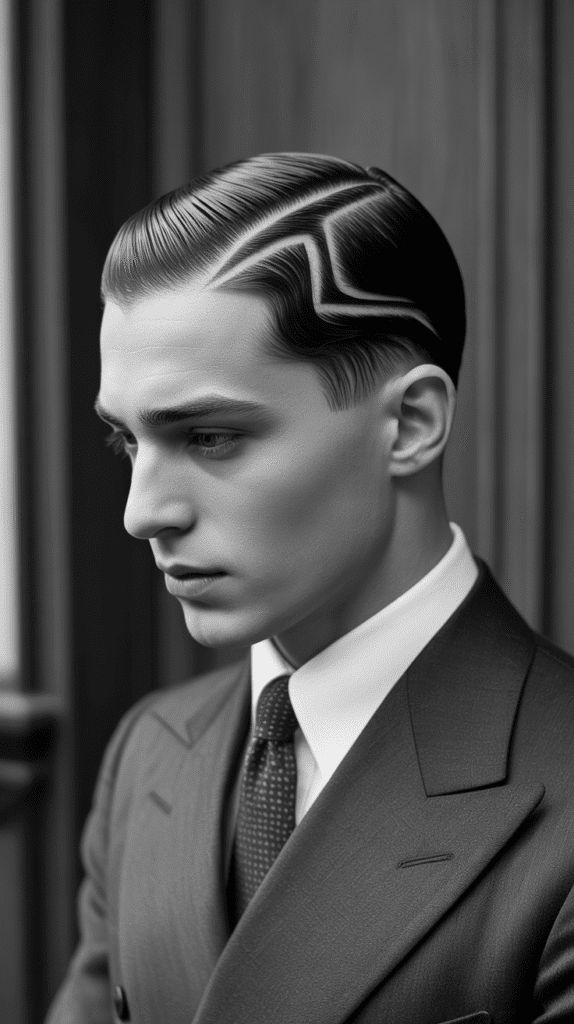
The sculpted part line elevated the simple side part into an art form, featuring precisely carved lines that created dramatic contrast and architectural interest.
This detail-oriented approach showcased the barber’s skill and the client’s commitment to grooming excellence.
- Barbers used straight razors or the fine edge of combs to carve razor-thin lines into the scalp along the part, creating visible white lines against the darker hair.
- The sculpted lines could be simple single parts or more elaborate designs featuring multiple lines or geometric patterns.
- This technique required extremely steady hands and years of barbering experience to execute without creating uneven or crooked lines.
- The sculpted part typically lasted 7 to 10 days before growing out enough to require reshaping during the next barbershop visit.
- This bold styling choice made a strong statement about personal style and attention to detail, separating fashion leaders from followers.
22. The Swept Forward Fringe
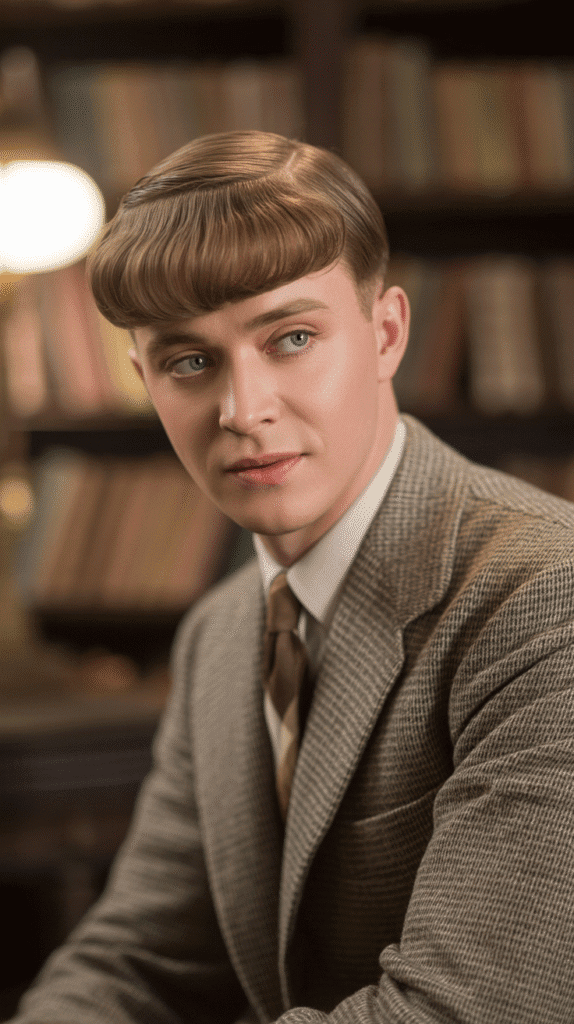
The swept forward fringe broke from the predominant backward styling of the era, directing hair toward the forehead in a style that projected youthful energy.
This less common approach appealed to younger men and those in artistic or creative fields.
- Hair at the front was cut to 2 to 3 inches and styled forward rather than back, often partially covering the forehead.
- The styling created a more casual, approachable appearance that contrasted with the formal sophistication of slicked-back looks.
- Medium-hold pomades allowed the hair to maintain direction while retaining some natural movement and texture.
- This style worked particularly well with naturally straight hair that easily fell forward without requiring excessive product or manipulation.
- The swept forward fringe suggested a progressive, modern attitude that challenged conventional grooming expectations.
23. The Vintage Ducktail
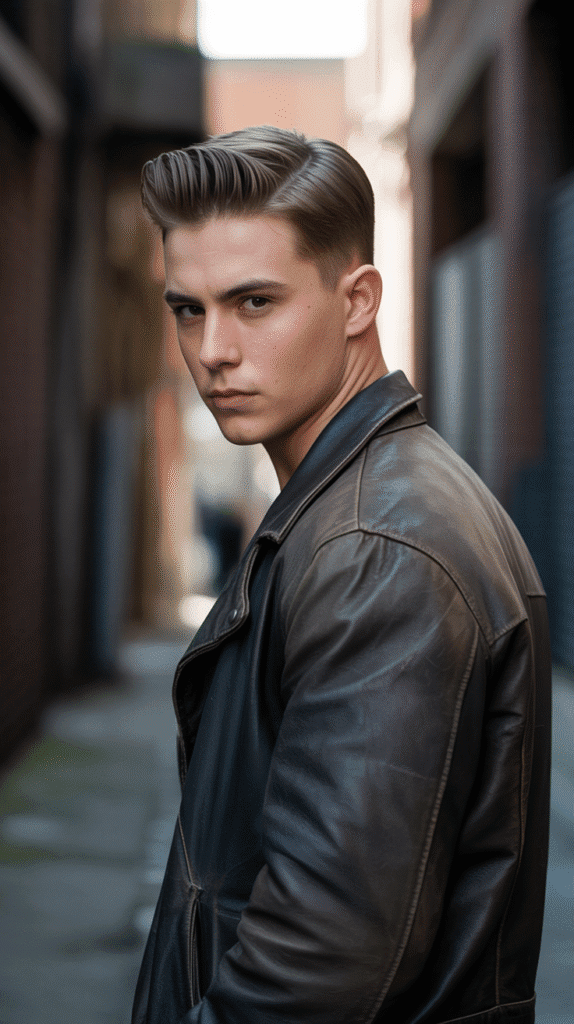
The vintage ducktail featured hair at the back shaped to meet in a point at the center nape, creating a distinctive V-shape that resembled a duck’s tail.
While more commonly associated with the 1950s, this style had its origins in late 1930s rebellious grooming trends.
- Barbers cut the back hair at angles that naturally drew inward toward the center, facilitating the pointed shape when styled.
- The sides were combed back toward the center back point, creating converging lines that emphasized the distinctive tail shape.
- Strong-hold pomades were essential for maintaining the precise shaping throughout the day, especially at the nape where hair naturally wanted to grow outward.
- This style particularly appealed to young working-class men and those in motorcycle or automotive subcultures who valued distinctive, non-conformist appearances.
- The ducktail represented early rebellion against conservative grooming standards, foreshadowing the more dramatic youth culture movements of subsequent decades.
24. The Professional Flat Top
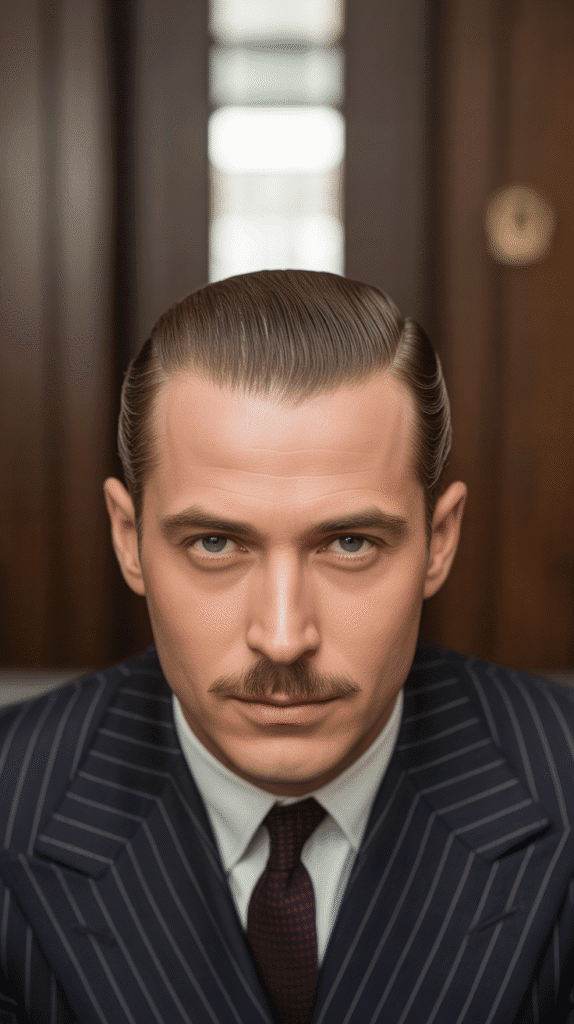
The professional flat top featured hair cut and styled to create a level, horizontal plane across the top of the head, projecting strength and decisiveness.
This geometric style required precise barbering and regular maintenance to preserve its distinctive silhouette.
- Barbers used special flat-top combs and scissors or clippers to create the perfectly level surface, checking from multiple angles to ensure uniformity.
- The hair stood upright at approximately 1 to 1.5 inches, supported by its natural texture and stiff pomades or waxes.
- The sides were cut very short with sharp lines defining where the flat top began, creating dramatic contrast and clean geometric shapes.
- This style worked best with naturally thick, coarse hair that had the body to stand upright without excessive product use.
- The flat top conveyed military precision and no-nonsense professionalism, appealing to men in leadership positions and those who valued disciplined self-presentation.
25. The Vintage Pompadour with Shine
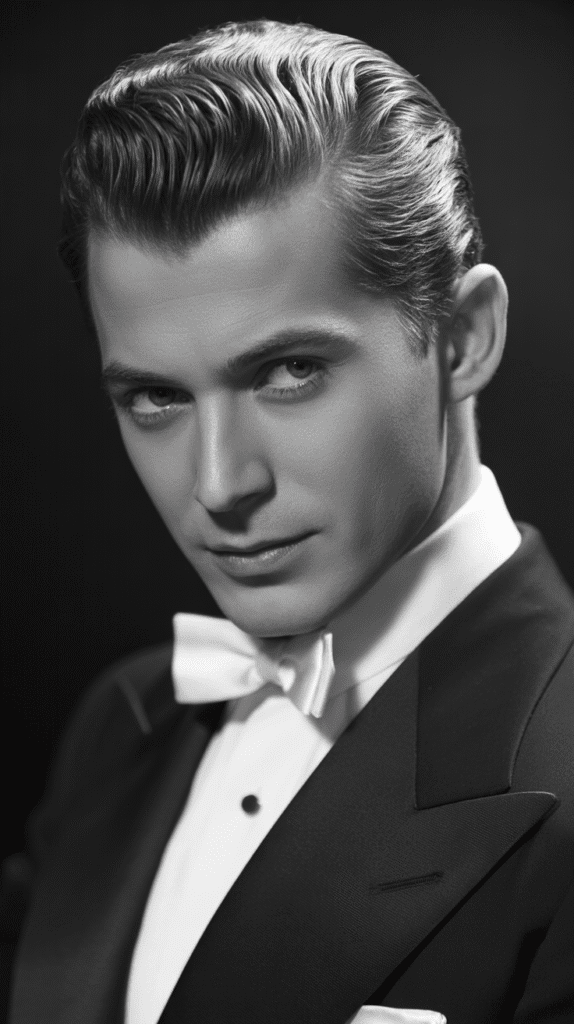
The vintage pompadour with shine took the classic pompadour to maximum glamor levels, using abundant product to create mirror-like reflective surfaces.
This high-impact style made bold statements in social settings and photographed dramatically.
- Multiple applications of heavy pomade or brilliantine created the characteristic high-gloss finish that caught and reflected light beautifully.
- The hair was combed into smooth, unbroken waves from front to back, eliminating any visible texture or individual hairs.
- This style required significant product investment and daily application, as the heavy pomades needed refreshing to maintain their shine and hold.
- The dramatic shine projected confidence and showmanship, making it popular among entertainers, salesmen, and socially ambitious men.
- Photography and film of the era captured this shine spectacularly, making it one of the most visually iconic hairstyles associated with the 1930s.
26. The Conservative Temple Trim
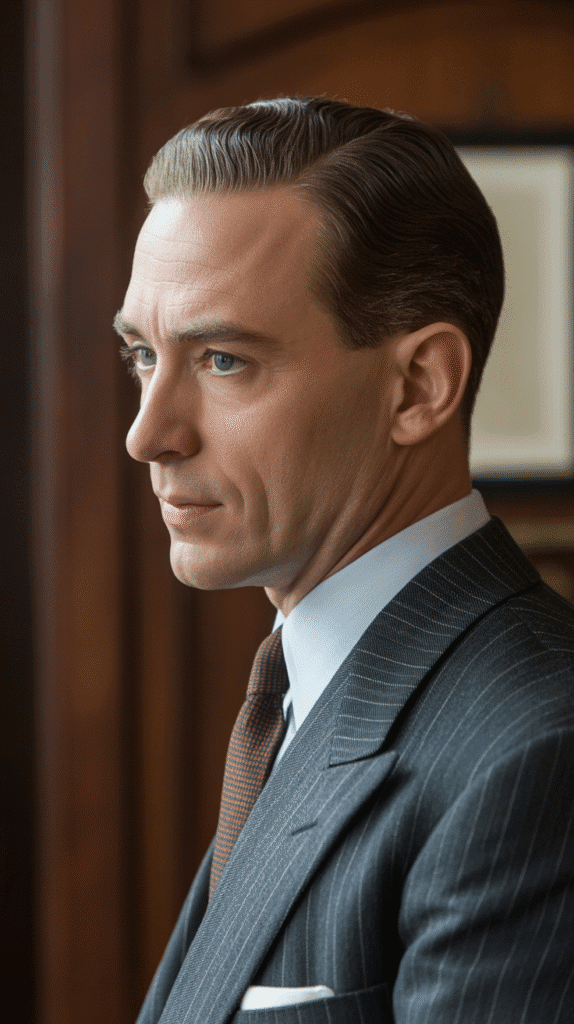
The conservative temple trim maintained maximum length on top while keeping the temple areas meticulously groomed and shaped.
This subtle but important detail work enhanced facial structure and created clean lines that defined professionalism.
- Barbers used trimmers or razors to create precise edges around the temple area, often extending the natural hairline slightly for cleaner definition.
- The temple shaping typically followed natural contours but could be adjusted to complement specific face shapes or personal preferences.
- This detail work required careful attention every 10 to 14 days to prevent the temples from appearing overgrown or unkempt.
- The conservative approach meant the trimming remained subtle and professional rather than dramatically noticeable.
- Well-maintained temples enhanced the overall polish of any hairstyle, serving as a mark of attention to grooming details.
27. The Layered Crown Cut
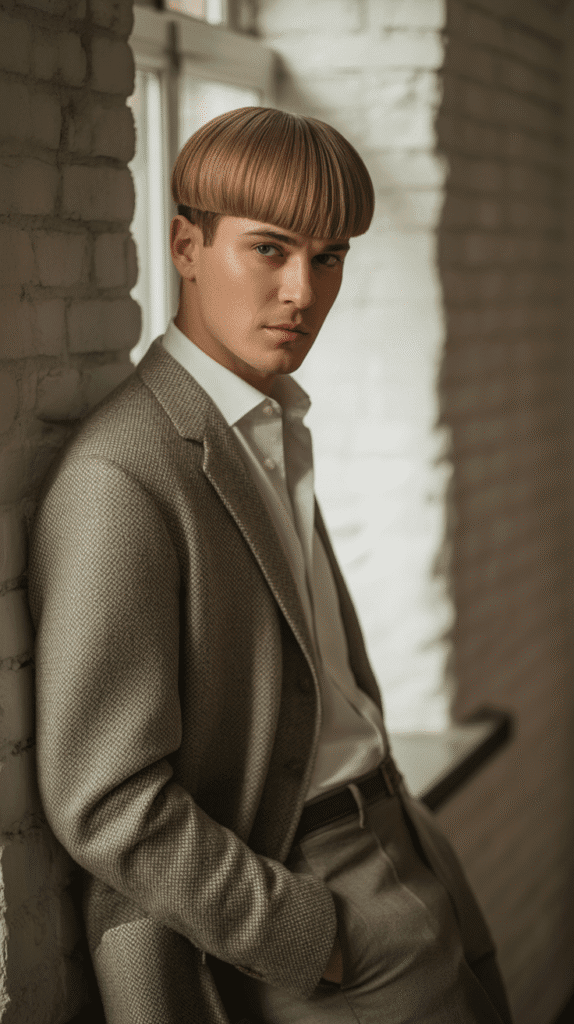
The layered crown cut used graduated lengths at the crown to create natural-looking volume and movement without heavy styling requirements.
This sophisticated cutting technique allowed hair to fall into attractive shapes with minimal product use.
- Barbers cut multiple layers at the crown, with the shortest layer at the top and gradually longer pieces underneath, creating built-in volume.
- The layering worked with the hair’s natural growth patterns and texture, making styling intuitive and quick.
- Light pomades or hair tonics enhanced the natural volume without weighing down the layers or eliminating the dimensional effect.
- This cut appealed to men who appreciated sophisticated styling but preferred more natural appearances over rigidly structured looks.
- The layered crown remained versatile, working well with various styling approaches from casual to formal.
28. The Urban Slick Back
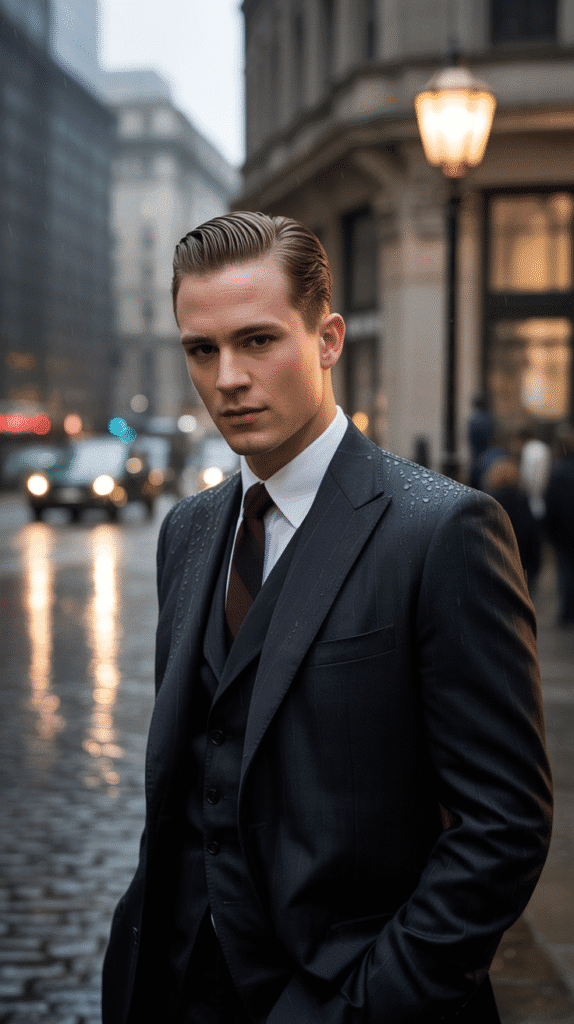
The urban slick back represented city sophistication, featuring hair combed straight back with a polished, wet-look finish that conveyed metropolitan style.
This cosmopolitan approach to grooming dominated urban centers and influenced provincial styling trends.
- The hair was saturated with heavy pomade or hair oil, creating the characteristic wet appearance that became synonymous with city life.
- Styling involved combing all hair directly back from the hairline without parting, creating smooth, uninterrupted lines.
- The length typically ranged from 3 to 5 inches on top, providing enough hair to create substantial slicked-back volume.
- This style worked well under the fedoras and other hats that urban gentlemen wore as standard accessories.
- The urban slick back projected worldliness and sophistication, marking the wearer as someone familiar with contemporary culture and style.
29. The Vintage Side Sweep with Volume
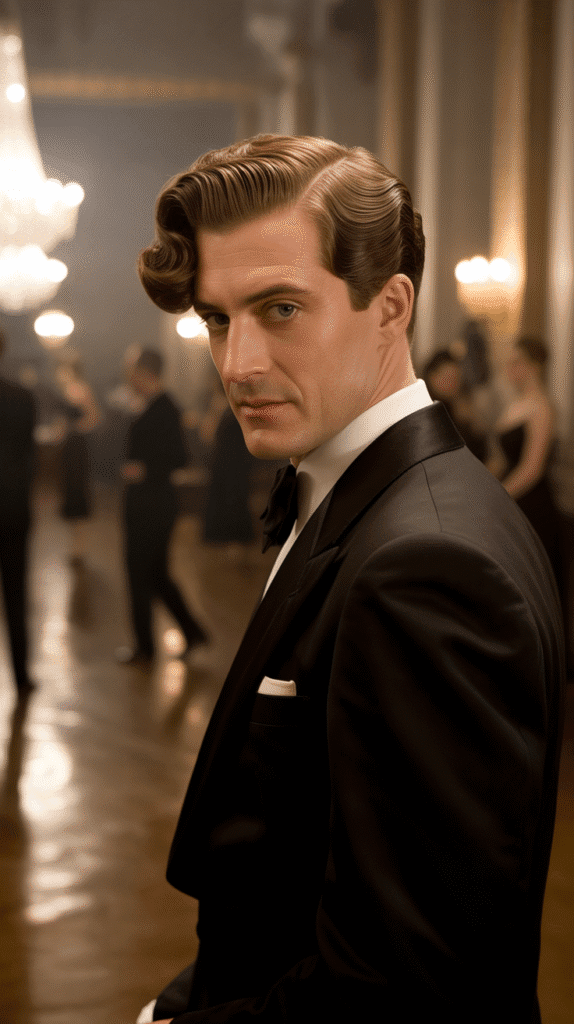
The vintage side sweep with volume combined directional styling with built-in fullness, creating a look that was both polished and substantial.
This approach added presence and impact to the classic side-swept style.
- The hair was cut with subtle layering that created natural volume when combed to the side rather than lying flat.
- Styling involved applying pomade to damp hair, then using a brush or comb to direct everything to one side while encouraging lift at the roots.
- The volume concentrated at the top and gradually decreased toward the ends, creating a pleasing dimensional effect.
- This style particularly complemented formal occasions and professional settings where making a strong impression was important.
- The added volume provided balance for men with longer or narrower face shapes, creating more proportional appearances.
30. The Working Man’s Practical Cut
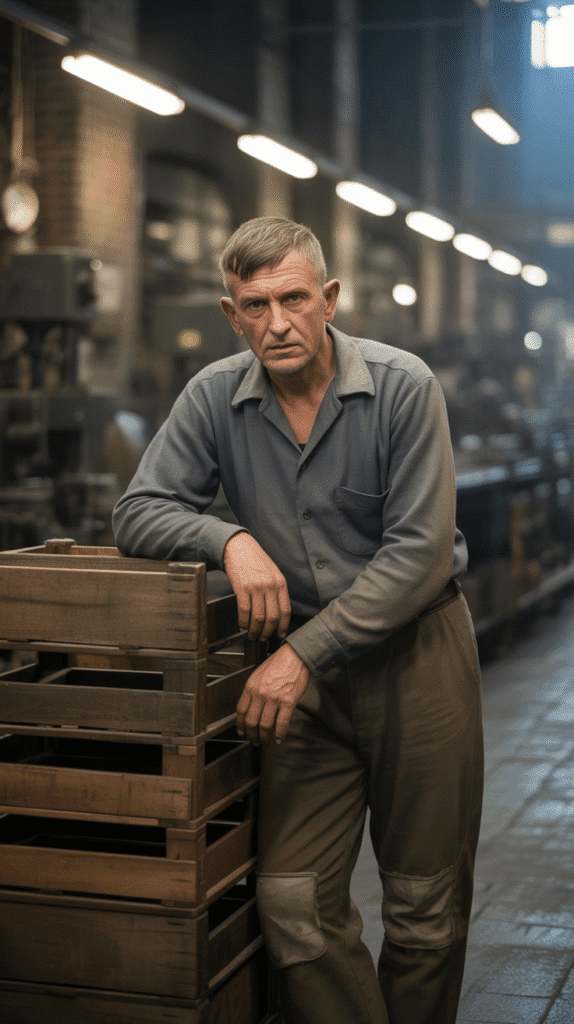
The working man’s practical cut prioritized functionality and low maintenance while maintaining respectable appearance standards.
This no-frills approach served the majority of 1930s men who needed to look presentable without investing significant time or money in grooming.
- Hair was cut to uniform medium-short length, typically 1 to 2 inches all over, requiring minimal styling effort.
- A simple side part or combed-back style could be achieved in minutes using small amounts of inexpensive pomade or even water.
- The cut withstood physical labor conditions, maintaining its general shape even when the wearer perspired or worked in challenging environments.
- Barbershop visits could be stretched to every 4 to 6 weeks without the haircut appearing significantly overgrown or unkempt.
- This practical approach reflected the economic realities of the Depression era, when most men needed to balance appearance with limited resources.
31. The Sophisticated Temple Fade
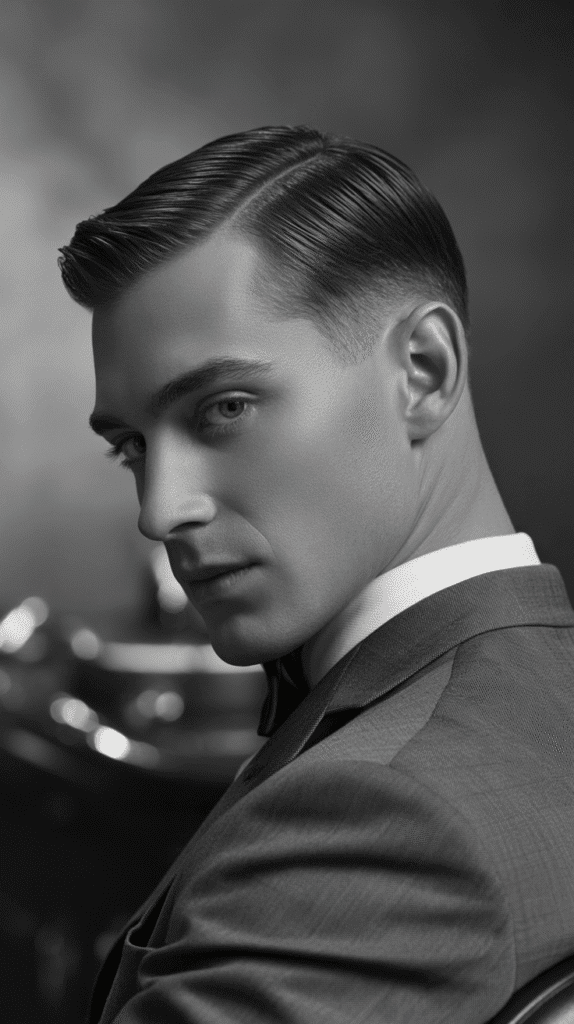
The sophisticated temple fade demonstrated advanced barbering techniques by creating seamless transitions from longer hair on top to clean skin at the temples.
This refined detail work enhanced the overall style with subtle but impactful precision.
- Master barbers used multiple tools including razors, clippers with various guards, and scissors to create the graduated fade effect.
- The fade typically began about an inch above the ear and gradually transitioned to skin level at the temple point.
- This technique required 15 to 20 minutes of careful work per side to achieve smooth, even results without visible lines or steps.
- The sophisticated temple fade enhanced facial symmetry and drew attention to strong facial features while maintaining conservative professionalism.
- Regular maintenance every 7 to 10 days was necessary to preserve the fade’s precision and prevent uneven growth from disrupting the effect.
32. The Classic Gentleman’s Wave
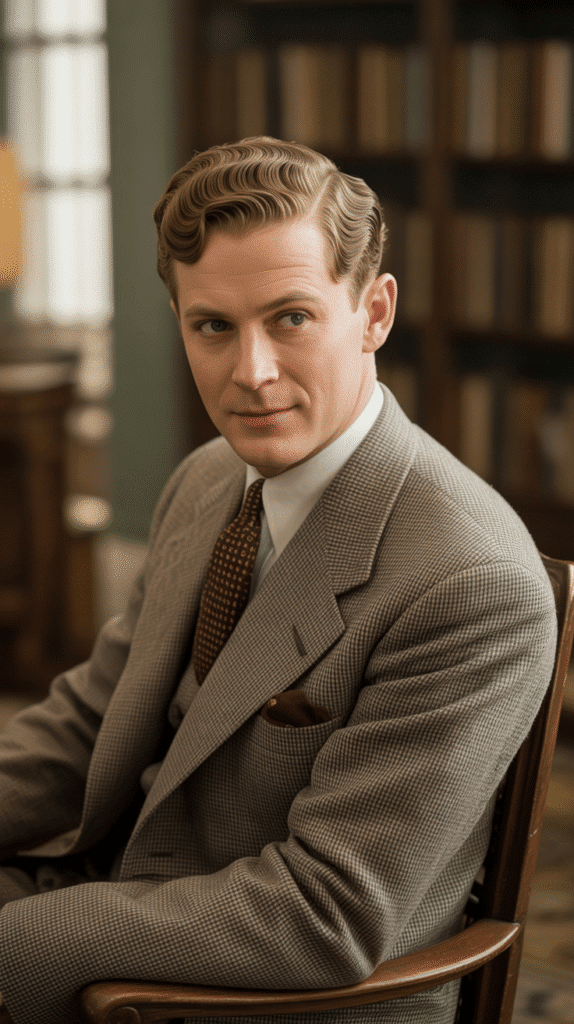
The classic gentleman’s wave celebrated natural hair texture while maintaining refined control, creating S-shaped patterns that added visual interest and dimension.
This style honored the hair’s inherent qualities while shaping them into socially acceptable forms.
- The waves were encouraged and enhanced through specific cutting techniques that worked with natural growth patterns rather than against them.
- Setting lotions or light pomades defined the waves without flattening them, creating structure while preserving natural movement.
- Styling involved combing the damp hair into wave patterns, then allowing it to dry naturally or using light heat to set the shape.
- This approach worked exceptionally well for men with naturally wavy hair who wanted to look polished without fighting their hair’s texture.
- The classic gentleman’s wave projected approachability.
33. The Art Deco Architectural Style
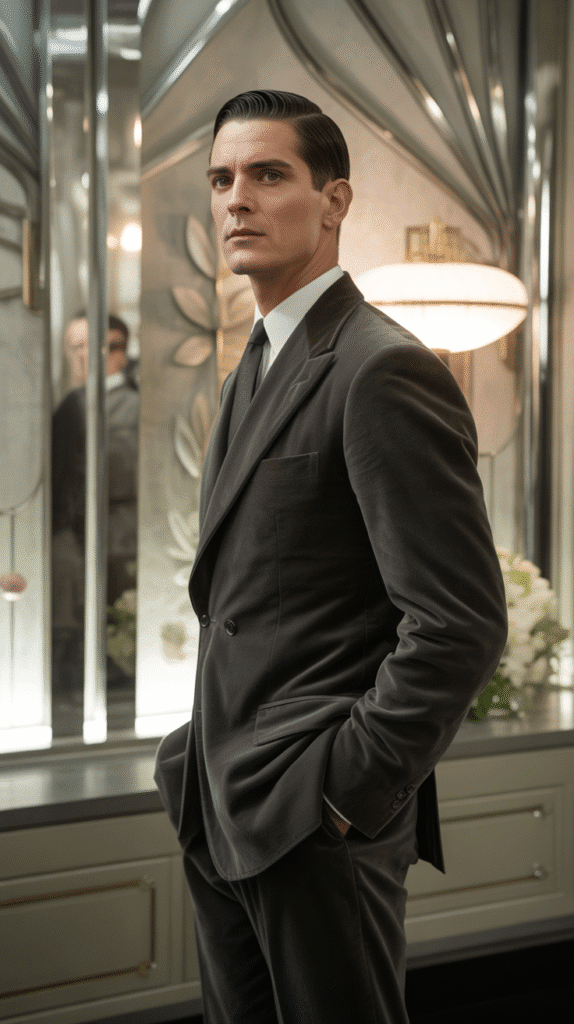
The Art Deco architectural style represented the pinnacle of 1930s hair artistry, incorporating geometric shapes and angular lines inspired by the era’s dominant design movement.
This avant-garde approach transformed hair into sculptural statements that reflected contemporary artistic trends.
- Barbers trained in advanced techniques created sharp angles, clean lines, and geometric patterns that echoed Art Deco architecture and design.
- The styling required exceptional skill with both cutting and product application, often taking 45 minutes to an hour to complete properly.
- Multiple pomade types with different hold strengths were used strategically to create contrasting textures and maintain complex shapes.
- This style appealed primarily to wealthy, fashion-forward men in major metropolitan areas who could afford frequent barbershop visits and premium grooming products.
- The Art Deco architectural style represented hair as wearable art, pushing the boundaries of what grooming could achieve and expressing the era’s optimism about modern design and human creativity.
Key Styling Techniques from the 1930s
The foundation of 1930s men’s hairstyling rested on several time-tested techniques that barbers and gentlemen mastered through practice and dedication.
- The proper comb angle determined whether hair lay flat against the scalp or lifted for volume, with barbers holding combs at precise 45-degree angles for optimal results.
- Product application timing made the difference between successful styling and frustrating results, as pomades worked best on damp rather than wet or completely dry hair.
- Directional combing involved working systematically from front to back or side to center, never randomly pushing hair in different directions that created chaos rather than control.
- The setting process required patience, as rushing through styling before products properly set resulted in styles that collapsed within hours rather than lasting all day.
- Layering techniques allowed barbers to combine different product types, applying lighter oils first for conditioning, then heavier pomades for hold and shine.
Cultural Significance of 1930s Men’s Hairstyles
The hairstyles of the 1930s extended far beyond mere fashion choices, reflecting deeper social, economic, and cultural currents that defined the decade.
- Economic depression influences meant that well-groomed hair became a way to maintain dignity and respectability despite financial hardships that affected most families.
- Hollywood’s impact cannot be overstated, as film stars like Clark Gable, Cary Grant, and Fred Astaire set grooming standards that millions of men aspired to emulate.
- Class distinctions were clearly visible in hairstyle choices, with elaborate pompadours and sculpted styles indicating wealth and leisure time, while simpler cuts suggested working-class practicality.
- Regional variations developed across different geographic areas, with urban centers embracing sleeker, more polished looks while rural areas maintained more conservative, functional approaches.
- Military influence grew throughout the decade, especially as the 1930s progressed toward World War II, with military-inspired cuts becoming increasingly common in civilian life.
How to Achieve Authentic 1930s Styling Today
Modern gentlemen interested in recreating authentic 1930s hairstyles can follow these guidelines for achieving period-accurate results with contemporary products and techniques.
- Choose water-based pomades rather than petroleum-based products for easier washing and more manageable daily styling that still provides authentic shine and hold.
- Invest in quality tools including fine-toothed combs, round brushes for volume work, and possibly vintage-style combs that replicate the tools original 1930s barbers used.
- Master the side part by finding your natural part line where hair naturally wants to separate, then using a rattail comb to create clean, precise divisions.
- Practice product application by starting with small amounts and building up gradually, as too much product creates greasy, heavy appearances rather than polished styling.
- Maintain regular barbershop visits every two to three weeks to keep cuts sharp and properly shaped, as 1930s styles depended heavily on precise cutting rather than just styling products.
- Study period photographs and films to understand the subtle details and variations that made each style distinctive, paying attention to part placement, volume distribution, and finish levels.
- Consider hair length requirements before committing to specific styles, as authentic 1930s looks typically required 3 to 5 inches on top for elaborate styles or consistent shorter lengths for military-inspired cuts.
Common Mistakes to Avoid
When attempting to recreate 1930s hairstyles, several common errors can prevent achieving authentic period looks and should be carefully avoided.
- Using too much product creates heavy, greasy appearances that look dated in negative ways rather than achieving the polished sophistication characteristic of well-executed 1930s styling.
- Ignoring hair texture leads to frustration, as fighting against natural curl patterns or straight hair’s tendencies makes styling unnecessarily difficult and results appear forced rather than natural.
- Skipping proper preparation means styling on completely dry or overly wet hair, both of which prevent products from distributing evenly and holding effectively throughout the day.
- Neglecting the back and sides focuses too much attention on top styling while allowing the foundation to grow out improperly, ruining the overall balance and proportion of the hairstyle.
- Choosing inappropriate styles for your face shape, hair type, or lifestyle needs results in styles that look awkward or require unsustainable maintenance commitments.
- Rushing the styling process produces sloppy results that undermine the refined appearance these hairstyles should project, as 1930s grooming emphasized patience and attention to detail.
Modern Adaptations and Contemporary Relevance
The enduring appeal of 1930s men’s hairstyles demonstrates their timeless quality and adaptability to contemporary contexts and personal style preferences.
- Barber shop revival movements have brought renewed attention to traditional cutting and styling techniques, with many modern barbers specifically training in vintage methods and period-accurate approaches.
- Fashion industry influence continues to reference 1930s aesthetics in runway shows, editorial photography, and men’s style magazines that celebrate classic masculine grooming.
- Popular culture appearances in films, television series, and music videos set in the 1930s or inspired by the era introduce these styles to new generations of men interested in distinctive looks.
- Hybrid styling approaches combine 1930s techniques with modern elements like undercut fades or textured finishes, creating fresh interpretations that honor tradition while embracing contemporary trends.
- Professional versatility makes many 1930s-inspired styles appropriate for today’s business environments, where classic grooming often conveys professionalism and attention to detail more effectively than trendy alternatives.
Conclusion
The exploration of 33 Stylish 1930s Hairstyles for Men That Define Retro Charm reveals far more than just historical grooming practices; it uncovers a rich tradition of masculine self-presentation that continues to influence contemporary style.
These hairstyles emerged from a unique moment in history when economic challenges, cultural shifts, and technological advances converged to create grooming standards that balanced practicality with sophistication.
Whether you’re drawn to the polished elegance of the classic pompadour, the professional simplicity of the side part, or the rebellious edge of early ducktail styling, the 1930s offers a comprehensive vocabulary of masculine grooming that remains remarkably relevant today.
The attention to detail, commitment to craftsmanship, and understanding that proper grooming reflects personal character are lessons that transcend decades and continue to resonate with modern men seeking to distinguish themselves through thoughtful self-presentation.
By studying and adapting these timeless styles, you’re not simply adopting vintage looks but connecting with a tradition of masculine elegance that valued quality, precision, and the understanding that how a man presents himself to the world matters deeply.
These 33 hairstyles represent not just fashion history but enduring principles of style, grooming, and personal dignity that remain as powerful and relevant in our contemporary world as they were nearly a century ago.